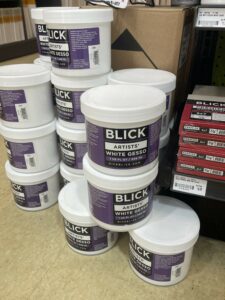Yes, you can mix house paint and oil paint, but you’ll lose some archival qualities of your work.
Just follow the steps below.
How to do it
Ok, so you are ready to make some multimedia work with house paint (i.e. latex paint) and oil paint. When I was in high school, I did this a lot, so I understand the allure. The latex is so glossy and intense; the oils are so rich and mysterious. Who wouldn’t want to combine them?
Fat over Lean
Well, you can paint with oil paint and house paint together but always paint the house paint FIRST.
The golden rule of oil painting layering: fat over lean.
Always paint fat over lean. This means that you should always paint richer, oil-filled paints on top of thinner, water-based paints.
- first, paint your house paint layer
- then, paint your oil paint
Can you paint latex and oil paint side-by-side?
Yes, but they will dry unevenly. Also, the house paint might turn a bit yellow over time.
Can you mix oil paint and house paint together?
God no! Don’t do this. Oil paint is made with special pigment and binder. Remember, oil and water don’t mix. For the same reason you don’t throw water into a sizzling oil-filled pan, you shouldn’t mix your paints.
If you want your oil paint to look more like house paint or vice versa, try layering your paint instead.
For example, paint a layer of house paint and then a very translucent, linseed oil-filled layer of oil paint on top. That way, you will see the hue of the house paint underneath your oil paint and the colors will optically mix.
-fat over lean
Understanding the Basics: House Paint vs. Oil Paint
House paint, or latex paint, is a water-based paint. It dries relatively quickly, and it is easy to clean up with water. People like its durability and weather resistance.
Oil paint, on the other hand, is an artist-grade paint. Professionals make it by mixing pigments with a binder, usually linseed oil. Artists like its vibrant colors, and long drying time, which allows for blending and layering). Many artists prefer oil paint due to its richness and versatility.
Mixing: The Pros and Cons
While mixing house paint and oil paint might not be the most conventional approach, it is possible.
Pros
- Cost-Effective: House paint is generally more affordable than artist-grade oil paint, making it a budget-friendly option for large-scale projects.
- Texture Variety: Mixing house paint with oil paint can result in interesting textural effects due to the differences in drying times and consistency.
- Extended Drying Time: House paint can slow down the drying time of oil paint, allowing for more extended working periods and blending.
Cons
- Compatibility Issues: House paints (acrylic paints) and oils have different properties, which can lead to adhesion problems and cracking over time. The oil in oil paint may repel water-based paints.
- Quality Concerns: The color intensity and vibrancy of artist-grade oil paint may be compromised when mixed with anything else.
- Long-Term Durability: The longevity of a painting created with this combination may be questionable, as house paint is not designed for art preservation.
Tips for Experimenting
If you’re eager to try this unconventional combination, here are some tips to make the process smoother:
- Surface Preparation: Start with a clean, primed canvas or surface to ensure proper adhesion.
- Test First: Always conduct a small-scale test before committing to a larger project to assess how the paints interact.
- Layering: Consider layering both types of paints rather than mixing them thoroughly. This approach may preserve the distinct characteristics of each paint type.
- Seal and Protect: Once your painting is complete and thoroughly dried, consider sealing it with a clear varnish to protect it from moisture and UV damage.
If this was helpful, check out these related posts.

